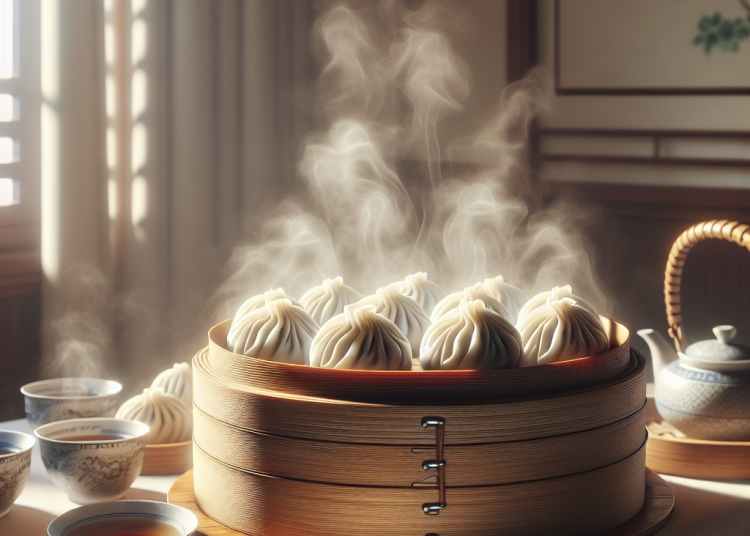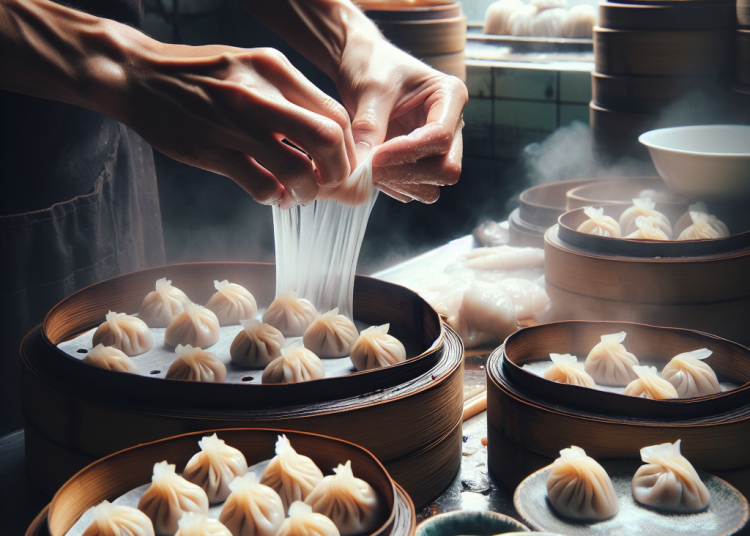Sitting down to a lively brunch with friends, envision the table adorned with steaming baskets filled with an assortment of bite-sized delights. Among these, Har Gow stands out—a classic dim sum dish known for its translucent, pleated wrapper and succulent shrimp filling. It offers a visual appeal with delicate folds and the promise of savory flavors deeply rooted in Cantonese culinary tradition. Dim sum is not just food; it’s an experience, a weekend ritual shared with family and friends, often involving tea and conversation about life’s stories.
Recipe

Ingredients
– 1 cup wheat starch
– 1/2 cup tapioca starch (or cornstarch)
– 1 1/4 cups boiling water
– 1 tablespoon vegetable oil
– 1 pound raw shrimp, peeled, deveined, and finely chopped
– 1 tablespoon soy sauce
– 1 teaspoon sesame oil
– 1 teaspoon grated ginger
– 1 clove garlic, minced
– 1/4 cup finely chopped bamboo shoots (optional)
– 2 green onions, finely chopped
– Salt and pepper to taste
– Additional vegetable oil for steaming
– Soy sauce for serving
Instructions
1. Mix wheat starch and tapioca starch in a bowl. Then add boiling water and stir. Next, add vegetable oil and knead into a smooth dough. Cover with a damp cloth.
2. Mix shrimp, soy sauce, sesame oil, ginger, garlic, bamboo shoots, and green onions. Season with salt and pepper.
3. Divide dough into small pieces and roll into circles. Place filling in the center and fold, pleating to seal.
4. Oil steamer basket. Place dumplings inside without touching.
5. Boil water in a wok or pot. Steam dumplings for 6-8 minutes.
6. Serve hot with soy sauce for dipping.
Cultural Significance and History


Dim sum, meaning “to touch the heart,” is a culinary art form that has been warming souls for over a thousand years. It started during the Song Dynasty in China, when roadside teahouses served these small bites to weary travelers and rural workers. Har Gow, with its shrimp filling, is a newer addition to the dim sum family but has become a favorite. The perfect Har Gow is judged by its almost translucent wrapper, which should be thin yet sturdy enough not to break with chopsticks, and the pleats—traditionally there should be at least seven, symbolizing prosperity.
You might wonder about the cost of enjoying such a delicacy. Surprisingly, Har Gow remains an affordable luxury. Depending on your location, a basket can range from $2 to $6. It’s a small price for a piece of cultural heritage. Traditionally, dim sum is consumed from morning to early afternoon, often on weekends, when life slows down enough to savor each bite and sip of tea.
The settings for enjoying dim sum have evolved. It was once exclusive to teahouses but can now be found in various eateries, from humble street-side vendors to high-end restaurants. The communal aspect of dim sum dining is central—it’s about sharing dishes, exchanging stories, and enjoying the company. This aspect of Chinese dining culture has spread worldwide, inviting everyone to partake in the tradition of Yum Cha, which translates to “drink tea,” and implies much more.
In recent years, chefs have been experimenting with Har Gow recipes, incorporating unique ingredients like truffle oil or adding twists to the classic shrimp mixture. Despite these gourmet upgrades, the essence of Har Gow remains the same—a simple yet sophisticated dish that continues to hold an important place in Cantonese cuisine. So next time you’re enjoying these delicate shrimp dumplings, remember you’re connecting with a centuries-old tradition that has reached from ancient China to the modern global table.

